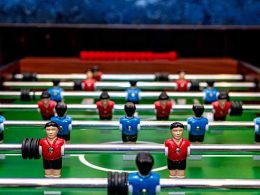As the clock struck midnight on December 2, 2021, the collective bargaining agreement (“CBA”) between Major League Baseball (“MLB”) and the Major League Baseball Players Association (“MLBPA”) expired. This left MLB commissioner Robert Manfred and MLB owners with a hefty decision to make–and a minute later they instituted a lockout.
The CBA sets the overall terms of the union’s relationship with management and regulates salaries, salary arbitration, free agency, rule changes, luxury taxes, and much more. In negotiating a CBA, the parties have multiple economic weapons at their disposal and Commissioner Manfred chose the weapon of a “defensive lockout.” Lockouts occur when the employer, in this case the team owners, close facilities to workers and prevent them from doing their jobs. Conversely, a strike is initiated by the employees, here the players, to withhold their services. During a lockout, all communications between the players and the clubs are halted until a new CBA is reached. By locking out the players, Commissioner Manfred claims to have the best interest of the coming season in mind. In his letter to baseball fans, Manfred explains that this lockout “was necessary because the Players Association’s vision for Major League Baseball would threaten the ability of most teams to be competitive.”1[1]Manfred, R. D. (2021, December 2). A letter to baseball fans. MLB.com. Retrieved January 31, 2022, from https://www.mlb.com/news/featured/a-letter-to-baseball-fans He later conveyed his disappointment with the MLBPA for being stagnant in their negotiations.
As negotiations advance and the sides’ respective positions crystallize, there are several legal implications of the lockout to consider.
The lockout was not required by law. In a statement challenging Manfred’s assertion that the lockout was necessary, the MLBPA categorized the lockout as a “dramatic measure,” and further stated, “[i]t was the owner’s choice… specifically calculated to pressure Players into relinquishing rights and benefits, and abandoning good faith bargaining proposals that will benefit not just Players, but the game and industry as a whole.”2[2]Yingling, Noah. “MLBPA Had a Perfect Response to MLB Owners’ Lockout.” Call to the Pen, FanSided, 2 Dec. 2021, https://calltothepen.com/2021/12/02/mlbpa-perfect-response-mlb-lockout/. The players proffer this theory, directly or indirectly, likely through the principle of status quo, a labor law standard that provides when a labor agreement expires, mandatory terms remain in effect until a new deal is reached or there is a deadlock in negotiations.3[3]29 U.S.C. § 8(d)(4) Mandatory terms are those that must be bargained for and include “wages, hours, and other terms and conditions of employment.”4[4]Id. at §8(d) Permissive terms can be unilaterally imposed by management, and the union is not entitled to demand to bargain about them.5[5]Id. Additionally, the NLRA describes the standards of behavior that both sides must follow. Both the employers and the union are obligated to supply all relevant information needed by bargaining representatives for the proper performance of its duties.6[6]Id. at §8(a)(5) Further, the employer must refrain from unilateral changes in employment conditions, whether to employee’s benefits or detriment, until impasse has been reached in bargaining.7[7]Id. After a genuine impasse has been reached, management can implement the final offer made to the union.8[8]Id. at §8 Although the two sides in baseball have met multiple times to negotiate, no substantial progress has been made as of this writing. However, that does not necessarily mean they have reached impasse.
A key element of the negotiations is the players’ push to increase minimum salaries. They also want the teams to stop manipulating service time to avoid paying players what they’re worth. The players accuse small market teams such as the Pittsburgh Pirates, Cleveland Guardians, Baltimore Orioles, and Miami Marlins of intentionally putting out a sub-par product while turning profit through the MLB revenue-sharing dollars. These clubs have consistently placed at the bottom of the standings for the last three to five years and continue to trade top talent to teams that can afford their salaries. The owners, on the other hand, are pushing to limit the amount of money big market teams such as the New York Yankees, New York Mets, and Los Angeles Dodgers can spend on player salaries. The MLB aims to balance competition and assist small market teams in retaining their big-name players. However, the MLBPA would need to agree on these restraints on team spending. This is unlikely, as it would limit a player’s earning capacity and their strength in negotiating large contracts.
At this point, all business between players and teams is frozen, and with each passing day, the risk increases of lost spring training and regular season games. Furthermore, teams cannot currently negotiate with free agents or engage in trade talks with other organizations. The domino effect reaches player arbitration, which typically occurs in February, and that process might be bypassed altogether if the parties don’t reach an agreement. Furthermore, with no deal in place and no games scheduled to be played, the players run the risk of not receiving salaries. Under the uniform player contract, players generally are compensated only during the season.
If the situation is not resolved, the judicial system could get involved. Court interference is not foreign to the MLB. In 1994-95, the players went on strike, resulting in 948 games being canceled including the post-season and World Series. The owners responded by unilaterally implementing a salary cap and hiring replacement players for spring training. The strike ended when future Supreme Court Justice Sonia Sotomayor issued a preliminary injunction against the salary cap and restored the expired CBA. Her decision induced the players and owners to return to the bargaining table and reach a new agreement.9[9]Silverman v. Major League Baseball Player Rels. Comm., 67 F.3d 1054 (2d Cir. 1995)
The current MLB owners have not indicated they plan such drastic action and so a lawsuit is not in sight at the moment. However, they have proposed federal mediation, which may be the only hope for spring training to start on time.
Written by: Spencer Markbreiter and Cooper Siegel
Spencer and Cooper are 2024 J.D. Candidates at Brooklyn Law School
1 Manfred, R. D. (2021, December 2). A letter to baseball fans. MLB.com. Retrieved January 31, 2022, from https://www.mlb.com/news/featured/a-letter-to-baseball-fans
2 Yingling, Noah. “MLBPA Had a Perfect Response to MLB Owners’ Lockout.” Call to the Pen, FanSided, 2 Dec. 2021, https://calltothepen.com/2021/12/02/mlbpa-perfect-response-mlb-lockout/.
3 29 U.S.C. § 8(d)(4)
4 Id. at §8(d)
5 Id.
6 § 8(a)(5)
7 Id.
8 Id. at §8
9 Silverman v. Major League Baseball Player Rels. Comm., 67 F.3d 1054 (2d Cir. 1995)




